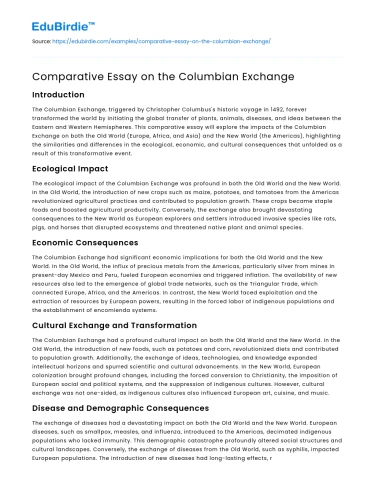Introduction
The Columbian Exchange, triggered by Christopher Columbus's historic voyage in 1492, forever transformed the world by initiating the global transfer of plants, animals, diseases, and ideas between the Eastern and Western Hemispheres. This comparative essay will explore the impacts of the Columbian Exchange on both the Old World (Europe, Africa, and Asia) and the New World (the Americas), highlighting the similarities and differences in the ecological, economic, and cultural consequences that unfolded as a result of this transformative event.
Ecological Impact
The ecological impact of the Columbian Exchange was profound in both the Old World and the New World. In the Old World, the introduction of new crops such as maize, potatoes, and tomatoes from the Americas revolutionized agricultural practices and contributed to population growth. These crops became staple foods and boosted agricultural productivity. Conversely, the exchange also brought devastating consequences to the New World as European explorers and settlers introduced invasive species like rats, pigs, and horses that disrupted ecosystems and threatened native plant and animal species.
Save your time!
We can take care of your essay
- Proper editing and formatting
- Free revision, title page, and bibliography
- Flexible prices and money-back guarantee
Economic Consequences
The Columbian Exchange had significant economic implications for both the Old World and the New World. In the Old World, the influx of precious metals from the Americas, particularly silver from mines in present-day Mexico and Peru, fueled European economies and triggered inflation. The availability of new resources also led to the emergence of global trade networks, such as the Triangular Trade, which connected Europe, Africa, and the Americas. In contrast, the New World faced exploitation and the extraction of resources by European powers, resulting in the forced labor of indigenous populations and the establishment of encomienda systems.
Cultural Exchange and Transformation
The Columbian Exchange had a profound cultural impact on both the Old World and the New World. In the Old World, the introduction of new foods, such as potatoes and corn, revolutionized diets and contributed to population growth. Additionally, the exchange of ideas, technologies, and knowledge expanded intellectual horizons and spurred scientific and cultural advancements. In the New World, European colonization brought profound changes, including the forced conversion to Christianity, the imposition of European social and political systems, and the suppression of indigenous cultures. However, cultural exchange was not one-sided, as indigenous cultures also influenced European art, cuisine, and music.
Disease and Demographic Consequences
The exchange of diseases had a devastating impact on both the Old World and the New World. European diseases, such as smallpox, measles, and influenza, introduced to the Americas, decimated indigenous populations who lacked immunity. This demographic catastrophe profoundly altered social structures and cultural landscapes. Conversely, the exchange of diseases from the Old World, such as syphilis, impacted European populations. The introduction of new diseases had long-lasting effects, reshaping demographics and leaving a lasting impact on the population dynamics of both hemispheres.
Conclusion
The Columbian Exchange was a transformative event that reshaped the ecological, economic, and cultural landscapes of both the Old World and the New World. While it brought benefits such as the introduction of new crops and the expansion of trade networks, it also resulted in ecological disruptions, exploitation, and the loss of indigenous cultures. Understanding the comparative impacts of the Columbian Exchange is essential to grasp the complex consequences of this historic event and its ongoing relevance in shaping our modern world.






 Stuck on your essay?
Stuck on your essay?

